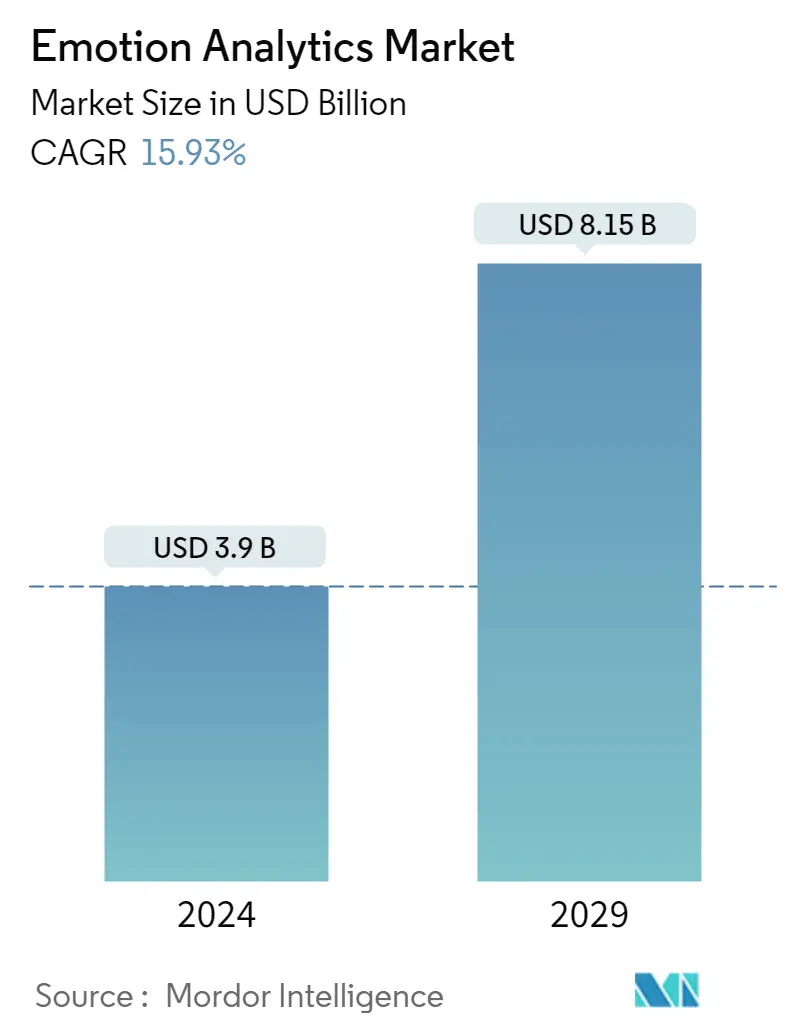Market Size of Emotion Analytics Industry

| Study Period | 2019 - 2029 |
| Market Size (2024) | USD 3.90 Billion |
| Market Size (2029) | USD 8.15 Billion |
| CAGR (2024 - 2029) | 15.93 % |
| Fastest Growing Market | Asia Pacific |
| Largest Market | North America |
Major Players
*Disclaimer: Major Players sorted in no particular order |
Emotion Analytics Market Analysis
The Emotion Analytics Market size is estimated at USD 3.9 billion in 2024, and is expected to reach USD 8.15 billion by 2029, growing at a CAGR of 15.93% during the forecast period (2024-2029).
Artificial intelligence (AI) has brought in a wave of digital transformation; the limitation of AI to understand human emotion remains a challenge. However, in the last decade, growing access to data, low-cost computing power, and evolving NLP capabilities, coupled with digital learning, have enabled systems to analyze emotions in humans. Key areas where emotion detection and recognition are expected to gain traction include entertainment (majorly gaming), transportation (autonomous cars), healthcare (various kinds of diagnostics), and retail (to enhance customer experience).
- The focus on customer experience enhancement is augmenting the spending on technologies that enable enterprises to gain consumer insights. According to Salesforce's consumer survey report, 84% of the customers mentioned that the company's experiences are as important to them as its services and products, and 62% of all customers were open to the use of AI to improve their experience. Such developments in the market are expected to augment the demand for technologies, such as emotion analytics.
- Owing to this, various vendors in the market, such as RealEyes and IBM, are increasingly launching several forms of API that are related to emotion detection and analysis. Furthermore, the launch of multi-modal solutions includes the integration of speech, text, and facial recognition. Also, the increasing role of muscle activity, brain activity, skin conductance, and heart rate monitoring in delivering better human emotional intelligence significantly led to huge customer awareness about the technology.
- The automotive industry is expected to be another major adopter of technology in the coming years. With the advent of autonomous cars, ADAS, and connected cars, the incorporation of IoT and sensors is on the rise; automotive vendors are expected to incorporate emotion analytics primarily for safety.
- The importance of comprehending human emotion in building effective brands, memorable customer experiences, and innovative content is now widely acknowledged. After all, buyer behaviour is influenced by emotions. Still feelings are all too frequently misunderstood or ignored. Organizations require the same emotional intelligence that individuals possess in order to comprehend their audiences and clients without forcing them to consider or even acknowledge their emotions. Traditional methods for understanding feelings are expensive, time-consuming, and not scalable.
- Also, Amid the COVID-19 situation, many people have shown signs of distress, as COVID-19 has taken an emotional toll. As a result, most of the population is turning to social media to express their feelings since they cannot do social interaction. This provides an opportunity for the vendors to explore their offerings. For instance, Expert System and Sociometrica use text analytics across social media to monitor people's emotions and general sentiments. Expert System's artificial intelligence technology extracts emotions from each published text, which are then analyzed and interpreted by Sociometrica.
Emotion Analytics Industry Segmentation
Emotion analytics, also known as affective computing, plays a crucial role by identifying and analyzing the entire human emotional spectrum, including mood, attitude, and dynamic personality, regarding brand perception and preferences. They serve as a tool for businesses to gauge customer loyalty to their brands. The reports cover the emerging trends in the emotion analytics market segmented by type, deployment, applications, end-user vertical across different regions studied.
The Emotion Analytics market is segmented by deployment (on-premise, cloud), application (customer service, product/market research, healthcare, automotive, education, gaming), and geography((North America, Europe, Asia-Pacific, Latin America, Middle East and Africa). The market sizes and forecasts are provided in terms of value (USD) for all the above segments.
| By Deployment | |
| On-Premise | |
| Cloud |
| By Application | |
| Customer Service | |
| Product/Market Research | |
| Healthcare | |
| Automaotive | |
| Education | |
| Gaming |
| Geography | |
| North America | |
| Europe | |
| Asia-Pacific | |
| Latin America | |
| Middle East and Africa |
Emotion Analytics Market Size Summary
The emotion analytics market is experiencing significant growth, driven by advancements in artificial intelligence and natural language processing. These technologies have enabled systems to analyze human emotions more effectively, overcoming previous limitations. Key sectors such as entertainment, transportation, healthcare, and retail are increasingly adopting emotion analytics to enhance customer experiences and improve safety measures. The automotive industry, in particular, is expected to be a major adopter, integrating emotion analytics into autonomous vehicles and connected cars. The market is also witnessing a surge in demand for voice and speech analytics, with companies like Amazon and Google leading innovations in this space. These developments are further fueled by the growing importance of understanding human emotions in branding, customer engagement, and content creation.
North America is poised to hold a significant share of the emotion analytics market, supported by its robust retail sector, substantial R&D investments, and high demand for IoT and smart wearables. The region's marketers are at the forefront of adopting technologies that provide consumer insights, driven by increasing advertising expenditures. The presence of key players such as Affectiva, IBM, and RealEyes in North America contributes to the region's dominance. Despite the market's consolidation, with a few players holding major shares, new entrants face challenges due to the high investment required and the demand for personalized user experiences. Recent developments, such as Kouo's AI-powered emotion analytics technology and Entropik's funding, highlight the ongoing innovation and investment in this rapidly evolving market.
Emotion Analytics Market Size - Table of Contents
-
1. MARKET INSIGHTS
-
1.1 Market Overview
-
1.2 Industry Attractiveness - Porter's Five Forces Analysis
-
1.2.1 Threat of New Entrants
-
1.2.2 Bargaining Power of Buyers/Consumers
-
1.2.3 Bargaining Power of Suppliers
-
1.2.4 Threat of Substitute Products
-
1.2.5 Intensity of Competitive Rivalry
-
-
1.3 Market Drivers
-
1.3.1 Growing IoT Applications and Adoption of Wearable Devices
-
1.3.2 Increasing Need for Advanced Marketing Tools
-
-
1.4 Market Restraints
-
1.4.1 Data Privacy Concerns and Data Regulation Adoption Across the World
-
-
1.5 Key Use Cases
-
1.5.1 Face Analytics
-
1.5.2 Video Analytics
-
1.5.3 Speech Analytics
-
1.5.4 Text Analytics
-
-
1.6 Assesment of Impact of COVID-19 on the Industry
-
-
2. MARKET SEGMENTATION
-
2.1 By Deployment
-
2.1.1 On-Premise
-
2.1.2 Cloud
-
-
2.2 By Application
-
2.2.1 Customer Service
-
2.2.2 Product/Market Research
-
2.2.3 Healthcare
-
2.2.4 Automaotive
-
2.2.5 Education
-
2.2.6 Gaming
-
-
2.3 Geography
-
2.3.1 North America
-
2.3.2 Europe
-
2.3.3 Asia-Pacific
-
2.3.4 Latin America
-
2.3.5 Middle East and Africa
-
-
Emotion Analytics Market Size FAQs
How big is the Emotion Analytics Market?
The Emotion Analytics Market size is expected to reach USD 3.90 billion in 2024 and grow at a CAGR of 15.93% to reach USD 8.15 billion by 2029.
What is the current Emotion Analytics Market size?
In 2024, the Emotion Analytics Market size is expected to reach USD 3.90 billion.

